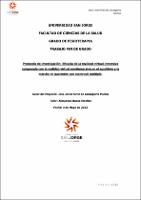Por favor, use este identificador para citar o enlazar este ítem:
https://repositorio.usj.es/handle/123456789/839
Registro completo de metadatos
| Campo DC | Valor | Lengua/Idioma |
|---|---|---|
| dc.contributor.advisor | Buesa-Estelléz, Almudena | - |
| dc.contributor.author | Ortiz de Lanzagorta Muñoz, José Javier | - |
| dc.date.accessioned | 2022-09-09T11:51:25Z | - |
| dc.date.available | 2022-09-09T11:51:25Z | - |
| dc.date.issued | 2022-05-03 | - |
| dc.identifier.uri | https://repositorio.usj.es/handle/123456789/839 | - |
| dc.description | Introduction and objectives: Multiple sclerosis (MS) is a chronic, inflammatory, demyelinating and autoimmune disease of the central nervous system (CNS) that mainly affects population aged 20 to 50 years. It is the main cause of disability due to non-traumatic neurological disease in young adults. It causes a wide range of signs and symptoms, among which gait difficulty is one of the most limiting. Gait instability is largely due to the vestibular system. In recent years, virtual reality treatment has been implemented, but without making much difference between the different types that exist. This protocol aims to test the effectiveness of immersive virtual reality on gait in patients with MS. Methods: A randomized controlled clinical trial will be conducted with 10 patients and a duration of 6 months. All patients should have a diagnosis of relapsing-remitting or secondary-progressive MS with a value between 3 and 5.5 on the EDSS scale. They will be divided into 2 groups of 5 patients, the control group will receive a treatment using semi-immersive virtual reality and the intervention group will receive the same treatment, but with immersive virtual reality. The primary variable Dynamic Gait Index will be used to assess gait, the MSQol-54 MS quality questionnaire and the GAITRite gait measurement instrument will also be used. Expected results: It is expected that there will be an improvement of the variables for both groups, being significantly higher in the intervention group. Conclusion: Thanks to the use of immersive virtual reality, an improvement in gait is achieved in patients with MS and therefore, an improvement in quality of life | es_ES |
| dc.description.abstract | Introducción y objetivos: La esclerosis múltiple (EM) es una enfermedad crónica, inflamatoria, desmielinizante y autoinmune del Sistema nervioso central (SNC) que afecta principalmente a población de 20 a 50 años. Siendo la principal causa de discapacidad por enfermedad neurológica no traumática en adultos jóvenes. Provoca grandes tipos de signos y síntomas, entre ellos dificultad en la marcha, siendo uno de los más limitantes. La inestabilidad en la marcha es gran parte debida al sistema vestibular. En los últimos años se esta implementado el tratamiento mediante realidad virtual, pero sin hacer mucha diferencia entre los diferentes tipos que existen. Mediante este protocolo se busca comprobar la efectividad de la realidad virtual inmersiva en la marcha en pacientes con EM. Métodos: Se realizará un ensayo clínico controlado aleatorizado con 10 pacientes y una duración de 6 meses. Todos los pacientes deberán tener diagnostico de EM remitente-recurrente o secundaria-progresiva con un valor entre 3 y 5.5 en la escala EDSS. Se dividirán en 2 grupos de 5 pacientes, el grupo control recibirá un tratamiento mediante realidad virtual semi inmersiva y el grupo intervención recibirá el mismo tratamiento, pero con realidad virtual inmersiva. Se utilizará la variable primaria Dynamic Gait Index para evaluar la marcha, también se utilizarán el cuestionario de calidad para EM MSQol-54 y el instrumento de medida de la marcha GAITRite. Resultados esperados: Se espera que haya una mejora de las variables para ambos grupos, siendo significativamente superior en el grupo intervención. Conclusión: Gracias al uso de la realidad virtual inmersiva se consigue una mejora en cuanto a la marcha en pacientes con EM y por ello, una mejora en la calidad de vida. | es_ES |
| dc.format.extent | 41 p. | es_ES |
| dc.format.mimetype | application/pdf | es_ES |
| dc.language.iso | spa | es_ES |
| dc.relation.requires | adobe/ PDF | es_ES |
| dc.rights | Attribution-NonCommercial-NoDerivatives 4.0 Internacional | * |
| dc.rights.uri | http://creativecommons.org/licenses/by-nc-nd/4.0/ | * |
| dc.subject | Esclerosis Múltiple | es_ES |
| dc.subject | Marcha | es_ES |
| dc.subject | Equilibrio | es_ES |
| dc.subject | Realidad Virtual | es_ES |
| dc.subject | Realidad Virtual Inmersiva | es_ES |
| dc.subject | Calidad de Vida | es_ES |
| dc.subject | Multiple Sclerosis | es_ES |
| dc.subject | Gait | es_ES |
| dc.subject | Balance | es_ES |
| dc.subject | Virtual Reality | es_ES |
| dc.subject | Immersive Virtual Reality | es_ES |
| dc.subject | Quality of Life | es_ES |
| dc.title | Protocolo de investigación: Eficacia de la realidad virtual inmersiva comparada con la realidad virtual semiinmersiva en el equilibrio y la marcha en pacientes con esclerosis múltiple | es_ES |
| dc.type | info:eu-repo/semantics/bachelorThesis | es_ES |
| dc.rights.accessrights | info:eu-repo/semantics/openAccess | es_ES |
| dc.contributor.affiliation | Universidad San Jorge | es_ES |
| Aparece en las colecciones: | Grado en Fisioterapia | |
Ficheros en este ítem:
| Fichero | Descripción | Tamaño | Formato | |
|---|---|---|---|---|
| Protocolo de investigación Eficacia de la realidad virtual inmersiva.pdf | 1,18 MB | Adobe PDF |  Visualizar/Abrir |
Este ítem está sujeto a una licencia Creative Commons Licencia Creative Commons

